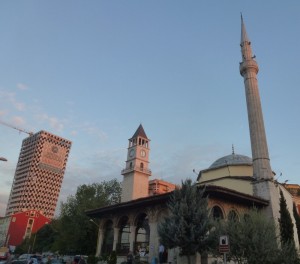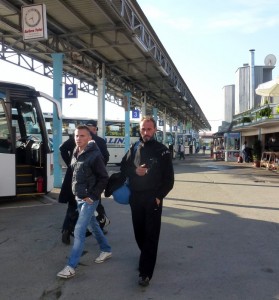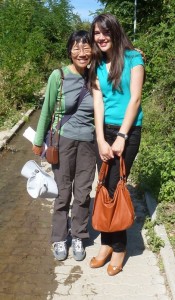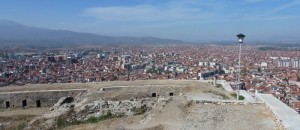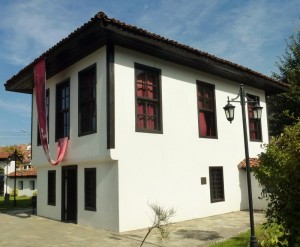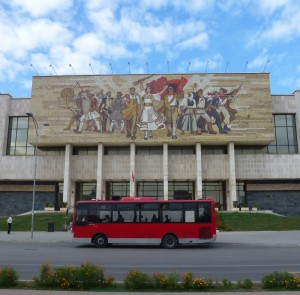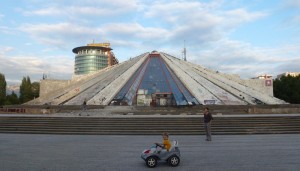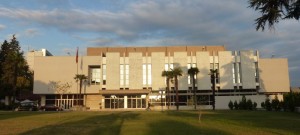Kosovo has a turbulent recent history. (Please see the background section in Balkans 3). The Kosovo War ended with the then Federal Republic of Yugoslavia accepting that it would give up the exercise of its sovereignty pending a final status settlement. Governance was passed to the UN in 1999. The Republic of Kosovo declared itself an independent state in 2008 though North Kosovo, the largest Serb enclave is largely under the control of Serbia or parallel structures subsidized by Serbia. As at today, 94 UN states recognize the independence of Kosovo and it has become a member country of the IMF and the World Bank. November 2012. Serbia and some countries still do not recognize the secession of Kosovo.
Kosovo has an area of 10,908 square kilometres and a population of 1.73 million (2011 census). Its total GDP and GDP per capita (nominal) 2011 estimate were $5.6 billion and $3,103 respectively. The GDP and GDP per capita (PPP) were $12.77 billion and about $7,000 respectively. About 92% of the population is ethnic Albanians.
October 9 (Tuesday): Novi Pazar, Serbia – Pristina, Kosovo – Prizren (200km)
My destination after Serbia was Prizren, Kosovo before going to Albania or Macedonia depending on the bus connection. I took the 10pm bus from Sarajevo, Bosnia to Novi Pazar, Serbia on October 8 and was back on Serbian soil after midnight. There was no delay on both sides of the border.
I was so tired that I slept most of the way to Novi Pazar. At 6am, I woke up just in time to move to another bus going to Kosovo. I planned to skip Pristina and went straight to Prizren.
The bus was full. I dozed off again till the bus reached the border check point where there are bunkers, barbed-wire and soldiers. I suddenly had the feeling that Kosovo is still under-siege. The countryside is not tidy and without the usual ‘European’ feel: there are many half-built concrete and brick houses. The road is not well-paved.
I discovered that the bus would go to Prizren after Pristina. Bingo! I was at Prizren before 10am. I checked into the City Hostel located in the old town. It is quiet and clean. I took a single room with shared bathroom for 15EUR. I took a hot shower and had a rest before sightseeing in the afternoon.
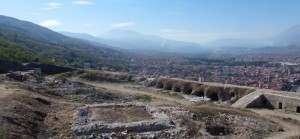 |
Prizren was conquered by the Ottoman in 1455 and became the cultural, economic and intellectual centre of Ottoman Kosovo. By mid- 19th century, majority of the population was Muslim and the city became the biggest Albanian cultural centre and the coordination political and cultural capital of Kosovar Albanians. It also became a focal point for Albanian nationalism and saw in 1878 the creation of the League of Prizren, a movement formed to seek the national unification and liberation of Albanians within the Ottoman Empire. During the First Balkan War, Prizren was seized by the Serbian army and incorporated into the Kingdom of Serbia. The Conference of Ambassadors in London in 1912 allowed the creation of the state of Albania and handed over Kosovo populated mostly by Albanians to the Kingdom of Serbia.
During the WWII, the city was annexed by the Italian puppet state of Albania. In 1944, the city was liberated by the communists of Yugoslavia and became part of Kosovo and Metohija under Democratic Serbia as a part of the Democratic Federal Yugoslavia. It has been an autonomous province since 1990.
Prizren has not suffered much during the Kosovo War. But during a riot in Kosovo in 2004, the entire Serbian quarter of Prizren near the Fortress was completely destroyed and all Serb cultural monuments in the city were damaged, burned or destroyed. Seven old Orthodox Serb Churches including Our Lady of Ljeviš from 1307 (a World Heritage Site) and the Church of St George are seriously damaged.
The municipality of Prizren though predominantly ethnically Albanian, is still the most culturally and ethnically heterogeneous of Kosovo with communities of Bosniaks, Turks and Roma. Albanian, Serbian, Bosnian and Turkish languages are official languages.
I had a leisure afternoon and went first to Our Lady of Ljeviš Church, a World Heritage Site famous for its frescoes. The church is locked and fenced off with barb-wire. I saw workmen working inside but I was told to leave. I then went to the St George Church which has since been renovated without much decoration. My third stop was the once impressive Prizren Fortress perching above the city. This massive ruin without signage dates backto the 5thcentury with a commanding view of the mountain ranges afar. A couple of workers were working on site.
 |
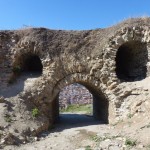 |
 |
It’s time for lunch and I had an enormous plate of meat fingers and salad. On the advice of a man I met at St George’s Church, I took a taxi to see a monastery along the river three kilometres away. The driver did not know the way and we eventually found the place which is under repair. As it is closed to visitors, I wasted some 6EUR on a taxi for nothing. Frustrating!
I got off at the Albanian House which was the base of the Prizren League for Greater Albania formed in 1878. There is no English explanation and I had no clue about the display. I only found out its history and significance when I visited the National History Museum of Albania the following day. I took a quick look at the Ethnological Museum and Art Gallery located in the same complex. The exhibits without explanations are appalling.
I strolled aimlessly in the old town and saw a couple of mosques and churches and a haman (bath house). I returned to the hostel for a rest before going to the bus station to buy a ticket to Tirana. It was 5:30pm and most of bus operators and travel agencies were closed. I was given confusing information on the bus departure time. Fortunately I found a lady from whom I got a ticket for 8am for 10EUR.
 |
 |
On my way back to the hostel, I passed by a small eatery with grilled chickens on charcoal. Though I was not hungry, the smell was irresistible: I brought a chicken for less than 3EUR. The chicken was juicy and fresh. I had a most delicious meal with a bottle of wine! As expected, I could not finish the chicken.
October 10: Prizren, Kosovo – Tirana, Albania – Ohrid, Macedonia (320km)
The modern-day territory of Albania was at various points in history part of the Roman provinces of Dalmatia, Macedonia and Moesia Superior. During the Ottoman rule, Albanians had enjoyed a privileged position as administrators and generals throughout the European, Arabian and African continents. The modern Republic created in 1912 after the Balkan Wars was invaded in 1939 by Fascist Italy and invaded by Nazi Germany in 1943. In 1944 a socialist People’s Republic was established under the leadership of Enver Hoxha and the Party of Labour. In 1991, the Socialist republic was dissolved and the Republic of Albania was established.
Albania’s transition from communist to free-market economy has largely been successful and now boasts Europe’s fastest growing economy. GDP and GDP per capita (nominal) in 2011 were estimated to be $12.85 billion and $3,992 respectively. But the GDP (PPP) was much higher at $7,741 (estimate). Its currency is called Albania Lek (ALL) which was about 110ALL to 1Eur.
Albania has a population of 2.8 million of which some 92-95% is ethnic Albanians. For religion, about 70% of the population is Muslims, 20% Eastern Orthodox and 10% Catholic.
 |
My minibus bus left Prizren at 8am with a dozen of passengers. It is a short drive to the border and then another 100km to Tirana, capital of Albania. The 250-km long Albania-Kosovo Highway cost some 800 million euros to construct, the biggest and most expensive infrastructure ever undertaken in Albania and Kosovo. It is the best highway I travelled so far in the Balkans.I believe improved infrastructureswill go a long way in facilitate and simulating economic and social development for Albania and Kosovo.
 I arrived in Tirana around noon. I planned to travel south to visit Girokastra, a World Heritage Site. But I was told that the journey could be long and uncomfortable. Someone suggested I take the 4pm bus to Ohrid, Macedonia. I found a hotel (Star Hotel) in the city centre where I reserved a room for October 13. In this way, I could leave my suitcase and travel light with a backpack for three days.Albania as compared with the other Balkan countries is least developed and organised. I was told to go to the Drita Travel to buy a ticket to go to Macedonia. The lady there said that there was no direct bus to Ohrid. Second, there was only one bus a day leaving at 7:30pm. Third, the bus would arrive at Struga around 11:30pm. Fourth, I could get a taxi for 3EUR from Struga to Ohrid which is close. I hate arriving in a new city in the middle of the night. But as there was no other option, I purchased a ticket reluctantly. My fear proved well founded.I started my afternoon sightseeing tour at the Skanderbeg Square. A statute of Albanian hero Skanderbeg on horseback stands at the centre of the square which is surrounded by the National History Museum, the Opera House, the Et’hem Bey Mosque (1821), Clock Tower (1820s) and some government buildings featuring Italian architecture. Former Enver Hoxer Museum
I arrived in Tirana around noon. I planned to travel south to visit Girokastra, a World Heritage Site. But I was told that the journey could be long and uncomfortable. Someone suggested I take the 4pm bus to Ohrid, Macedonia. I found a hotel (Star Hotel) in the city centre where I reserved a room for October 13. In this way, I could leave my suitcase and travel light with a backpack for three days.Albania as compared with the other Balkan countries is least developed and organised. I was told to go to the Drita Travel to buy a ticket to go to Macedonia. The lady there said that there was no direct bus to Ohrid. Second, there was only one bus a day leaving at 7:30pm. Third, the bus would arrive at Struga around 11:30pm. Fourth, I could get a taxi for 3EUR from Struga to Ohrid which is close. I hate arriving in a new city in the middle of the night. But as there was no other option, I purchased a ticket reluctantly. My fear proved well founded.I started my afternoon sightseeing tour at the Skanderbeg Square. A statute of Albanian hero Skanderbeg on horseback stands at the centre of the square which is surrounded by the National History Museum, the Opera House, the Et’hem Bey Mosque (1821), Clock Tower (1820s) and some government buildings featuring Italian architecture. Former Enver Hoxer Museum
My first stop was the National History Museum which is said to be one of the best in the Balkans. I gain some understanding of Albania as a nation since Antiquity as I can read the explanations in English. I learn that Albania was once a recognized power in the Balkans and parts of the present-day Macedonia, Kosovo and Montenegro belonged to Albania. Its most famous native daughter Mother Teresa, a Nobel Prize winner in 1979 for her humanitarian work in India was an Albanian born in a village which is now in Macedonia. There are detailed explanations on the Prizren League formed in 1878 as a centre for Albanian nationalism. Unfortunately the information on its developments under Enver Hoxha who had kept Albania isolated for decades is scanty. I also did not find much on the fall of communism and Albania today. I noticed one section was closed and wonder whether it is the section on modern Albania. There is a fabulous collection of icons.
My second stop was the National Art Gallery which has a modest collection of works by Albanian artists. One floor contains typical stylistic paintings during the communist era. I was enticed by the smell of grilled chicken and had half of a grilled chicken for 300ALL (more than 2EUR) in a local eatery. It is cheaper than Prizren.
I then followed a walking trail indicated in a tourist map passing the Murat Toptani Street before reaching The Block- an area which was reserved solely for government officials and was off-limit for commoners. Since opening to the public in 1991, it with its elegant shops, eateries and nightclubs has become the hot spot particularly for the capital’s youth and trendy folks. I walked past the Piramida (International Centre of Culture) which was once a museum for Enver Hoxha.
 I arrived at the Et’hem Bey Mosque and spent some time inside this cozy and stylish mosque. Time passed slowly as there was not much I could do while waiting for the bus to leave at 7:30pm. There were some 10 passengers on the bus. All except me and another girl got off at Durres to catch an overnight ferry to Bari, Italy.
I arrived at the Et’hem Bey Mosque and spent some time inside this cozy and stylish mosque. Time passed slowly as there was not much I could do while waiting for the bus to leave at 7:30pm. There were some 10 passengers on the bus. All except me and another girl got off at Durres to catch an overnight ferry to Bari, Italy.
I was frustrated when the driver told me to wait for an hour for a coach which would go to Macedonia. The truth is that the long-distance bus left Tirana at 8pm and our minibus only took passengers to Durres. The lady of Drita Travel had lied to me. I would rather get on that bus direct in Tirana at 8pm.
Our coach arrived at the border at 11:30pm. There was another coach waiting on the Macedonian side. I boarded another coach at midnight. But the bus did not leave the border for another 20 minutes. I was finally dropped off in a petrol station in Struga at 00:45am.



